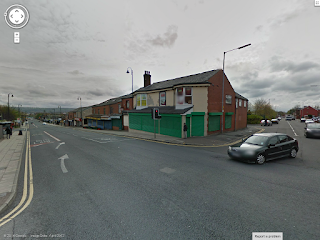While a waste disposal skip may seem an odd choice to illustrate a point, this skip, and the fenced-off area next to it, mark the approximate site of the Wellington (formerly the Welcome Traveller) on Union Buildings. On the other side of the wall is the Bolton-Blackburn railway line. Right behind us is the now-closed Anchor. To the right is Bradshawgate and in the distance are the flats in the former Bolton County Grammar School on Great Moor Street.
We dealt with one of the pubs on Union Buildings, a small
street some 40-50 yards in length that still exists just off Bradshawgate, when we looked at the Anchor, a
building that still stands and which only ceased to be a pub a few years ago. Now
let’s look at the other pub.
It’s hard to believe but there were initially two pubs along
that short stretch. The first pub to be opened on Union Buildings was the Welcome
Traveller situated just across the street from the Anchor at number 11.
Nicholas Heyes was listed on the 1849 list of the Great
Bolton beerhouses as the landlord of the Welcome Traveller. The pub isn’t
listed in the 1843 Bolton Directory although Mr Heyes (or Heys as his surname
was spelt) is listed on the 1841 Census as residing in Union Buildings, most
likely at the same address. At that time he was 27 years old, employed as a
cotton spinner and lived at the address with his wife, Margaret, his two
children and 20-year-old John Heys, presumably another relative.
Mr Heyes obviously decided in the mid-1840s to take
advantage of the 1830 Beer House Act which enabled common householders to open
a room in their house for the sale and consumption of beer – a public house –
so he opened the Welcome Traveller at number 11 Union Buildings.
The Welcome Traveller was re-named the Wellington later in
the 1850s, according to Gordon Readyhough [1]. A clue as to why it chose that name can
be found at the National Archives in Kew, which holds records for the
Wellington Benefit Building Society, which was listed as being at the Welcome
Traveller on Union Buildings. It is
entirely possible that it became a branch of a building society after it ceased
to be a pub, but it is also likely that the Welcome Traveller housed a branch
of a building society and changed its name to that of the financial
institution. Certainly, there were
branches of the Wellington Benefit Building Society in Manchester and
Liverpool, as well as in Bolton, although it had been struck off the Register
of Friendly Societies by1 January 1913. [2]
The pub remained in the Heyes family for some years. Nicholas
Heyes died in 1873 and his wife, Margaret, took over. In 1883, another of
Nicholas Heyes’ children, also named Nicholas, married Mary Ann Garrity at Holy
Trinity Church. The 23-year-old Nicholas was described as a ‘beerseller’
residing at 11 Union Buildings – the Wellington. His father, the late Nicholas
Heyes, was described as a ‘common brewer’ which suggests the pub brewed its own
beer at one time as well as for other pubs . Deposits were taken from small
savers and mortgages arranged. Heyes was known to own a number of properties in
the town centre.
After Mary’s death, the younger Nicholas Heyes managed a
number of pubs, including the Bridge Inn on Bridge Street and the Falcon on Kay
Street. By 1911, he was living on Huntroyde Avenue and working as a brewer.
The Wellington closed in 1906 by which time it was owned by
John Hamer’s brewery based at the Volunteer Inn at Bromley Cross. The building
no longer exists and it seems the Wellington closed because of the needs of the
railway. Additional sidings were constructed next to the Bolton to Blackburn
line and that necessitated the demolition of a number of the buildings at the top
of Union Buildings. An 1891 map of the town centre shows the buildings at the
top end of the street clearly visible along with Heyes Court directly behind the Wellington.
In the 1910 map the area has been swept away.
[1] Pubs Of Bolton 1800-2000, by Gordon Readyhough.
Published by Neil Richardson (2000).
[2] National Archives. Accessed 29 May 2014.
Follow us on Twitter:



























